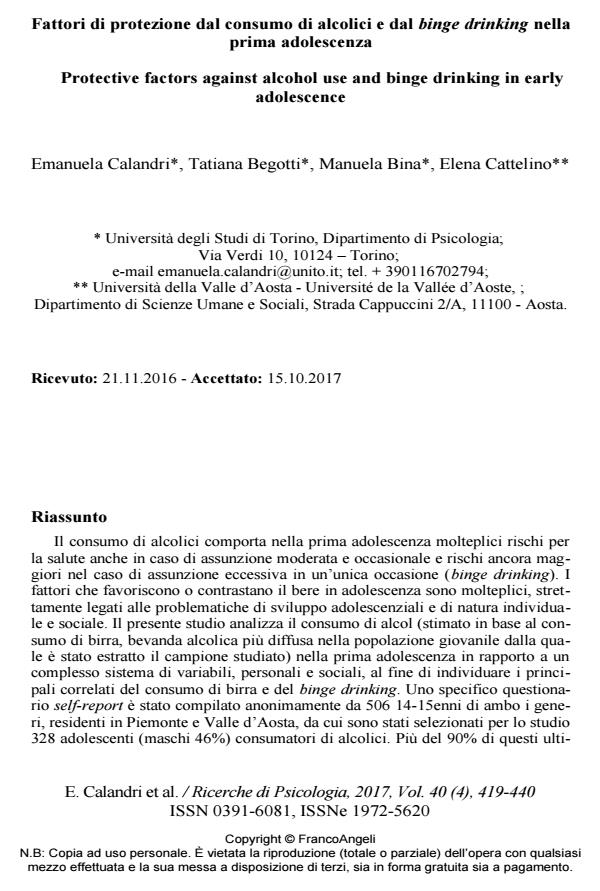Fattori di protezione dal consumo di alcolici e dal binge drinking nella prima adolescenza
Titolo Rivista RICERCHE DI PSICOLOGIA
Autori/Curatori Emanuela Calandri, Tatiana Begotti, Manuela Bina, Elena Cattelino
Anno di pubblicazione 2017 Fascicolo 2017/4
Lingua Italiano Numero pagine 22 P. 419-440 Dimensione file 229 KB
DOI 10.3280/RIP2017-004003
Il DOI è il codice a barre della proprietà intellettuale: per saperne di più
clicca qui
Qui sotto puoi vedere in anteprima la prima pagina di questo articolo.
Se questo articolo ti interessa, lo puoi acquistare (e scaricare in formato pdf) seguendo le facili indicazioni per acquistare il download credit. Acquista Download Credits per scaricare questo Articolo in formato PDF

FrancoAngeli è membro della Publishers International Linking Association, Inc (PILA)associazione indipendente e non profit per facilitare (attraverso i servizi tecnologici implementati da CrossRef.org) l’accesso degli studiosi ai contenuti digitali nelle pubblicazioni professionali e scientifiche
Il consumo di alcolici comporta nella prima adolescenza molteplici rischi per la salute anche in caso di assunzione moderata e occasionale e rischi ancora maggiori nel caso di assunzione eccessiva in un’unica occasione (binge drinking). I fattori che favoriscono o contrastano il bere in adolescenza sono molteplici, strettamente legati alle problematiche di sviluppo adolescenziali e di natura individuale e sociale. Il presente studio analizza il consumo di alcol (stimato in base al consumo di birra, bevanda alcolica più diffusa nella popolazione giovanile dalla quale è stato estratto il campione studiato) nella prima adolescenza in rapporto a un complesso sistema di variabili, personali e sociali, al fine di individuare i principali correlati del consumo di birra e del binge drinking. Uno specifico questionario self-report è stato compilato anonimamente da 506 14-15enni di ambo i generi, residenti in Piemonte e Valle d’Aosta, da cui sono stati selezionati per lo studio 328 adolescenti (maschi 46%) consumatori di alcolici. Più del 90% di questi ultimi ha bevuto birra negli ultimi due mesi, in misura maggiore maschi e quindicenni, mentre il 31% è incorso in almeno un episodio di binge drinking nello stesso periodo, senza differenze statisticamente significative legate al genere o all’età. Il coinvolgimento in entrambi i comportamenti è principalmente legato a fattori sociali, quali il bere nei contesti amicali e il bere in presenza dei genitori. Fra i fattori personali, l’autoefficacia regolatoria è significativamente legata a un minore coinvolgimento. A fini di prevenzione, i risultati evidenziano l’importanza di agire in questa specifica fascia d’età non solo a livello individuale e del gruppo dei pari, ma anche a livello familiare.
Parole chiave:Alcol, binge drinking, prima adolescenza, fattori di protezione, rischio, autoefficacia regolatoria.
- Stili educativi genitoriali, benessere scolastico e rendimento scolastico in adolescenza Maria Giulia Olivari, Eleonora Mascheroni, Gaia Cuccì, Emanuela Confalonieri, in RICERCHE DI PSICOLOGIA 1/2019 pp.9
DOI: 10.3280/RIP2019-001001
Emanuela Calandri, Tatiana Begotti, Manuela Bina, Elena Cattelino, Fattori di protezione dal consumo di alcolici e dal binge drinking nella prima adolescenza in "RICERCHE DI PSICOLOGIA " 4/2017, pp 419-440, DOI: 10.3280/RIP2017-004003